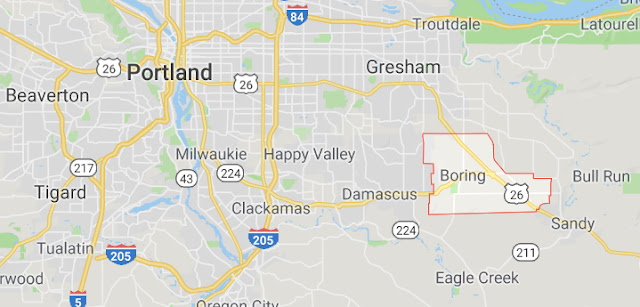Sandy is a city located in Clackamas County, Oregon, United States, settled c. 1853 and named after the nearby Sandy River. Located in the foothills of the Cascade Mountain Range, the city serves as the western gateway to the Mount Hood Corridor, and is located approximately 27 miles east of Portland.
The city of Sandy was originally settled by travelers passing along Barlow Road, one of the final sections of the Oregon Trail, and initially known as Revenue, after settlers Francis and Lydia Revenue. The city subsequently took the name Sandy after the Sandy River, named by Meriwether Lewis and William Clark in 1805; the river and previously been named the Barings River, after Sir Francis Baring, 1st Baronet, following a 1792 expedition in the region.
In the late-19th and early 20th century, Sandy's local economy was mainly based on logging and the sawmill industry due to the abundance of timber in the area. The city continued to grow with the arrival of German immigrants in the late-nineteenth century, and the city was formally incorporated in 1911. In the latter half of the 20th century, the city's population saw a significant increase in residents, concurrent with the growth of the Portland metropolitan area.
As of the 2010 census, the city had a total population of 9,570. It is the home of Sandy High School, founded in 1914, which serves the population of Sandy as well as outlying communities, such as Boring and the Villages of Mount Hood.
Sandy was founded after pioneer Sam Barlow passed through the area in 1845 and formed Barlow Road, the most widely-used final portion of the Oregon Trail. The first people to settle the area were Francis and Lydia Revenue, c. 1853. The abundance of natural resources in the area, ranging from fish, deer, elk, berries and roots, attracted them to build a homestead and trading post. Around 1873, the Revenues built the city's first hotel.
Initially known as Revenue (after the Revenue family), in the late-nineteenth century the settlement took its namesake of Sandy from the nearby Sandy River, which itself had taken its name from Meriwether Lewis and William Clark during their 1805 expedition, who at that time named it the "Quicksand River" due to the abundance of sand on its banks. The river had priorly been named the Barings River after Sir Francis Baring, 1st Baronet, an English merchant banker, by Lieutenant W.R. Broughton of the Fort Vancouver expedition on October 30, 1792.
A second hotel was erected in Sandy in 1890 by Baron Otto Von Scholley, an Austrian immigrant who also served as the city's second postmaster and first notary. In 1894, the city completed its first church, St. Michael's Roman Catholic Church, established by Benedictine monks, which had its first service on December 18 that year. Though the original building was destroyed in a fire two decades later, it was relocated and reopened.
^Sandy in 1917
^Sandy today
Our Buffalo Potato Wedges are made for chowing down while watching the big game, or any game, over the weekend. The zesty flavors of this easy-to-make recipe pack the perfect punch for any sporty get-together, or for a family night in. One thing's for sure, most anything is better covered in Buffalo sauce. These fries are no exception!
- 1/4 cup olive oil
- 1 teaspoon salt
- 6 large Idaho baking potatoes, washed and cut into lengthwise wedges
- 1/2 cup wing sauce
- 1/2 cup blue cheese dressing
- 2 celery stalks, chopped
- Preheat oven to 425º.
- In a large bowl, combine oil, salt, and potatoes; toss until evenly coated. Arrange on two rimmed baking sheets.
- Bake 30 minutes. Turn potatoes and continue cooking another 20 to 25 minutes, or until golden and crispy.
- Place potatoes in a large bowl, add wing sauce, and toss until evenly coated. Place potatoes on large platter and top with blue cheese dressing and celery. Serve immediately.
1947 – Cheryl Tiegs, American model
1951 – Mark Hamill, American actor
1952 – Christopher Reeve, American actor (d. 2004)
1961 – Heather Locklear, American actress and model
1969 – Catherine Zeta-Jones, Welsh actress
National Lobster Day on September 25th takes a taste of a seafood favorite.
The simplest way to enjoy Lobster is boiled then dipped in melted butter. A couple of favorite lobster recipes include Lobster Newberg and Lobster Thermidor. It is also the main ingredient in soup, bisque, lobster rolls and salads.
Large lobsters are estimated to be 50 years old.
These marine crustaceans live at the bottom of the ocean. If they avoid the lobster pot, some can live up to 100 years old. Even though we consider them a delicacy today, that wasn’t always the case. In colonial times, the lobster received very little culinary credit. In fact, the pigs and goats ate more lobster than the well-to-do.
While lobsters arrive at our tables bright red, they don’t start out that way. In the ocean, they come in many colors. Some are yellow, green or even blue.
Now that lobsters rank higher on the menu, consider these nutrition facts.
- Lobsters contain no carbohydrates and 27.55 grams of protein per 1 cup serving.
- In that same 1 cup serving, there’s 129 calories and 1.25 grams of fat.
- Eating lobster offers an excellent source of selenium, omega-3 fatty acids, vitamin A, and calcium.
We’ve found several delicious recipes to try. Let us know which one you like best!
Did you know there’s even a Lobster Newburg Day? Check out this recipe for Lobster Newburg.
According to the Guinness World Records, the largest lobster ever caught was in Nova Scotia, Canada, weighing 44.4 lbs.
NATIONAL LOBSTER DAY HISTORY
In 2014, Senators Angus King and Susan Collins of Maine drafted a joint resolution designating September 25th as National Lobster Day. The proclamation recognizes the men and women in an industry as well as the long and rich heritage, from sea to table.
National Lobster Day on September 25th takes a taste of a seafood favorite.
The simplest way to enjoy Lobster is boiled then dipped in melted butter. A couple of favorite lobster recipes include Lobster Newberg and Lobster Thermidor. It is also the main ingredient in soup, bisque, lobster rolls and salads.
Large lobsters are estimated to be 50 years old.
These marine crustaceans live at the bottom of the ocean. If they avoid the lobster pot, some can live up to 100 years old. Even though we consider them a delicacy today, that wasn’t always the case. In colonial times, the lobster received very little culinary credit. In fact, the pigs and goats ate more lobster than the well-to-do.
While lobsters arrive at our tables bright red, they don’t start out that way. In the ocean, they come in many colors. Some are yellow, green or even blue.
Now that lobsters rank higher on the menu, consider these nutrition facts.
- Lobsters contain no carbohydrates and 27.55 grams of protein per 1 cup serving.
- In that same 1 cup serving, there’s 129 calories and 1.25 grams of fat.
- Eating lobster offers an excellent source of selenium, omega-3 fatty acids, vitamin A, and calcium.



















No comments:
Post a Comment